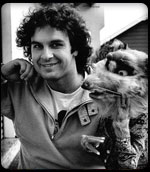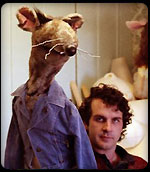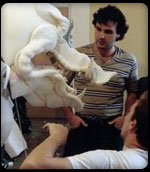PETER JACKSON BIOGRAPHY
 Peter Jackson was born in Pukerua Bay, New Zealand, a small seaside town not far from the country's capital city, Wellington. An only child, Jackson's imagination was inspired by a picturesque coastline of cliffs and caves. At an early age, he was captivated by the television series Thunderbirds. With its marionettes, futuristic vehicles and ingenious special effects, it fed his interest in science fiction and model building. By age nine he had commandeered the family's home movie camera to make his own short films, trying to reproduce the special effects he loved. His imagination received another powerful stimulus when he first saw the 1933 film King Kong on television. The next morning, he began experimenting with the stop-motion animation technique that had so excited him in the movie.
Peter Jackson was born in Pukerua Bay, New Zealand, a small seaside town not far from the country's capital city, Wellington. An only child, Jackson's imagination was inspired by a picturesque coastline of cliffs and caves. At an early age, he was captivated by the television series Thunderbirds. With its marionettes, futuristic vehicles and ingenious special effects, it fed his interest in science fiction and model building. By age nine he had commandeered the family's home movie camera to make his own short films, trying to reproduce the special effects he loved. His imagination received another powerful stimulus when he first saw the 1933 film King Kong on television. The next morning, he began experimenting with the stop-motion animation technique that had so excited him in the movie.
For the rest of his childhood and adolescence he continued to make short films,  devising his own special effects and painstakingly animating models inspired by the fantastic monsters he admired in the films of the American animator and director Ray Harryhausen. At 16, he dropped out of school and took a job as apprentice engraver in a newspaper's photography department, living with his parents to save money for camera equipment and film. When he acquired his first 16mm camera, he set out to make a short film to familiarize himself with the equipment. This project, a tongue-in-cheek science fiction horror fantasy called Bad Taste, gradually grew into a full-length feature film. The project would consume four years of his life. While his contemporaries were going to university or embarking on more conventional careers, Jackson continued to labor every weekend on his project. He wrote, directed and photographed the film, building all of the models and special effects, playing multiple roles, including the lead, and recruited neighbors and friends to fill out the cast.
devising his own special effects and painstakingly animating models inspired by the fantastic monsters he admired in the films of the American animator and director Ray Harryhausen. At 16, he dropped out of school and took a job as apprentice engraver in a newspaper's photography department, living with his parents to save money for camera equipment and film. When he acquired his first 16mm camera, he set out to make a short film to familiarize himself with the equipment. This project, a tongue-in-cheek science fiction horror fantasy called Bad Taste, gradually grew into a full-length feature film. The project would consume four years of his life. While his contemporaries were going to university or embarking on more conventional careers, Jackson continued to labor every weekend on his project. He wrote, directed and photographed the film, building all of the models and special effects, playing multiple roles, including the lead, and recruited neighbors and friends to fill out the cast.
 A grant from the New Zealand Film Commission enabled Jackson to quit his day job while he edited and scored his homemade feature. To his surprise, the Commission decided to send Jackson's film to the 1987 Cannes Film Festival. Astonishingly, Bad Taste, with its amateur actors and improvised special effects, charmed the festival goers, and Jackson landed deals to distribute the film commercially in 12 countries.
A grant from the New Zealand Film Commission enabled Jackson to quit his day job while he edited and scored his homemade feature. To his surprise, the Commission decided to send Jackson's film to the 1987 Cannes Film Festival. Astonishingly, Bad Taste, with its amateur actors and improvised special effects, charmed the festival goers, and Jackson landed deals to distribute the film commercially in 12 countries.
Fresh from his triumph at Cannes, Jackson returned home as a certified professional filmmaker. New Zealand's film industry was still in its infancy, but the head of the country's film commission, James Booth, had faith in Jackson's talent, and formed a partnership to produce Jackson's next two features. The partners followed up the surprise success of Bad Taste with a raunchy puppet film, Meet the Feebles (1990). Like Bad Taste, Meet the Feebles acquired a cult following. Jackson's first professional live action feature, Braindead (released as Dead Alive in the United States), established him on the international scene as an accomplished director of horror films, one with a refreshingly giddy sense of humor. As Jackson assembled a team of trusted collaborators, he co-founded a production facility, Weta Workshop, to provide special effects for his films.
By this time, Jackson had formed a professional and personal partnership with screenwriter Fran Walsh. Although the pair thoroughly enjoyed their horror and fantasy creations, they were looking for a project that demonstrated a wider range. In Heavenly Creatures (1994), they dramatized one of the most shocking murder cases in New Zealand's history, that of a teenage girl who murdered her mother with the assistance of her best friend. Jackson showed unusual sensitivity in exploring the relationship between the two disturbed young girls, and employed his growing expertise with special effects to render the girls' shared world of fantasy. The film won international acclaim, including an Oscar nomination for Jackson and Walsh's screenplay, and focused the industry's attention on the film's hitherto unknown teenage star, Kate Winslet.
Jim Booth's untimely death brought Peter Jackson to a crossroads in his career. In a break from conventional feature film production, he indulged both his love of cinema history and his penchant for parody in the mock-documentary Forgotten Silver (1995), recreating the history of motion pictures, as seen through the career of a fictitious New Zealand filmmaker. Jackson returned to his genre roots with The Frighteners, a comedy horror film starring Michael J. Fox as a psychic private detective.
In a little less than a decade of nonstop movie-making, Jackson and his team had built up a formidable special effects production capability, and were ready for a large scale project. Jackson dreamed of an epic fantasy with swordplay and monsters, along the lines of Ray Harryhausen's Sinbad films. As Jackson and Fran Walsh struggled to develop an original fantasy story, they found themselves repeatedly referring to The Lord of the Rings, the beloved trilogy of fantasy novels by J.R.R. Tolkien (1892-1973). Jackson and Walsh had both read and loved the books as young people, but they assumed the film rights were already held by a major studio and that other producers and directors would have preemptive claims to the material.
As it happened, the film rights to the novels were owned by independent producer Saul Zaentz, who had made a fortune with the jazz and rock record label Fantasy Records before producing such prestigious motion pictures as Amadeus and The English Patient. Zaentz had already produced an animated version of The Lord of the Rings. The animated feature had failed at the box office, and outraged fans of the books by compressing all three novels into a single film. Zaentz had no interest in revisiting the material. At the time, Peter Jackson had a producing deal with Harvey Weinstein of Miramax Films, and Weinstein was able to procure the rights from Zaentz. The project took several years to develop. When Miramax was sold to The Walt Disney Company, Disney ordered Weinstein to concentrate on lower-budget projects. Disney insisted that the sprawling trilogy be compressed into a single feature film. Jackson firmly believed this abridgement would be another betrayal of material treasured by millions of readers around the world.
After trying every other studio, Jackson finally found a backer in New Line Cinema. New Line was ready to support a daring scheme of Jackson's to film all three books of the trilogy simultaneously. Filming the entire cycle at once would enable the filmmakers to use the same sets in all three films without tearing down and rebuilding. It would also avoid the potentially crippling salary increases the film's mostly unknown stars would demand if the first installment proved to be a success. The savings of shooting all three pictures concurrently would be substantial if the films were successful, but if the first part failed at the box office, the second two parts might well go unfinished and the losses would be enormous. It was a tremendous gamble, but New Line had faith in Jackson's vision for the material.
Jackson insisted on shooting the entire trilogy in his native New Zealand, to take advantage of the country's spectacular scenery and the special effects production capacity he had built up in his previous films. While a more modest motion picture might complete principal photography in a month or two, The Lord of the Rings shoot kept an international cast on location in New Zealand for a year and a half.
The first part of the trilogy, The Fellowship of the Ring, was released in 2001. It won an enthusiastic reception from fans of the books, who saw their story brought to the screen with unmistakable respect and affection. The film's appeal extended far beyond the core audience of Tolkien enthusiasts, winning widespread critical acclaim and a massive international audience. The film received 13 Oscar nominations. The second part, The Two Towers (2002), was another box office smash and received an even more enthusiastic critical reception than the first. Expectations for the third part of the trilogy were raised to an almost unbearable level. No one could imagine how the third film of the series could possibly meet the standard set by the first two. No one but Peter Jackson, that is.
When The Return of the King was released in 2003, it not only met expectations, it exceeded them. Audiences found a thrilling and satisfying conclusion to the long tale, and critics acclaimed it as the strongest entry in the series, the finest fantasy film ever made. Oscar voters agreed. The Return of the King won the year's Oscar for Best Picture, along with writing honors for Fran Walsh and the Best Director Oscar for Peter Jackson. The film won in every category in which it was nominated, 11 Oscars in all, tying the records set by Ben Hur and Titanic. The Return of the King grossed over $1 billion in its first release. The trilogy as a whole is the highest-earning film series ever made.
After eight years of continuous work on The Lord of the Rings, Jackson might have been expected to take a long break, but by the time the third installment was released, he had already thrown himself into realizing a lifelong dream: a remake of King Kong, employing state-of-the-art special effects to bring the story to new audiences. Jackson received a $20 million advance against the film's gross receipts, the most lucrative deal ever made by a motion picture director. Again, Jackson chose to create his fantasy world in his native New Zealand. Unlike a previous remake, Jackson kept the action set in the 1930s, but he employed an army of computer animators to make the film's spectacular monsters utterly believable and to make the giant gorilla of the film's title into a fully developed character. The actor Andy Serkis, who had provided the movements for the animated character Gollum in The Lord of the Rings, performed the same duty for Kong, through the process of motion capture, in which electrodes placed at various point around the actor's face and body relay his movements to computers, where they are reproduced exactly by the computer-generated character.
Jackson's King Kong got off to a relatively slow start at the box office, with a disappointing first weekend in the United States, but within a few weeks it had found its audience around the world. It became one of the most successful films of the year, and its DVD and home video sales are among the highest ever recorded. After ten years of nearly continuous work, Jackson finally allowed himself the time off he had so long postponed.
The New Zealand film industry has grown considerably since Peter Jackson began making movies in his parents' back yard. In 1998, only four feature films were made in New Zealand; a decade later, as many as 20 films were produced there in a single year. Jackson's Weta Workshop and Weta Digital are leading providers of special effects and animated characters for films all over the world. The Wellington complex includes three vast sound stages, post-production facilities, design studios, and warehouses full of specialized props and vehicles.
From this stronghold, Jackson enjoys long-distance collaboration with the world's other leading filmmakers, including James Cameron and Steven Spielberg. Jackson provided special effects for Cameron's 3-D science fiction epic Avatar and oversaw post-production of Spielberg's film version of the classic Belgian children's comic strip Tintin. Jackson plans to direct the second Tintin feature himself, with Spielberg producing. The summer of 2009 saw the release of District 9, a science fiction allegory set in South Africa, directed by a Jackson protégé, Neill Blomkamp. Jackson produced the film and financed its initial development. After overcoming a series of contractual delays, Jackson is also producing and co-writing the film version of Tolkien's The Hobbit, to be directed by Guillermo del Toro.
Despite these extensive production activities, Peter Jackson continues to direct as well. Jackson and Fran Walsh have adapted the best-selling novel The Lovely Bones by Alice Sebold, in which a murdered girl looks down from heaven and recalls her life and death, while watching her family and friends go on without her. The film's release in December 2009 demonstrates Jackson's directing talents once again. Jackson and Walsh make their home in New Zealand's Miramar peninsula. They have two children.